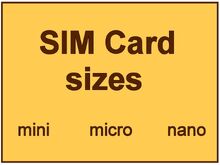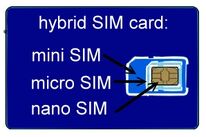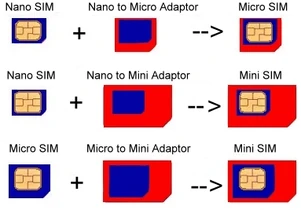(Difficulties when changing devices if physical presence is required) Tag: Visual edit |
(→iPhone) Tag: Visual edit |
||
| (One intermediate revision by the same user not shown) | |||
| Line 10: | Line 10: | ||
=== '''eSIM '''(embedded SIM) === |
=== '''eSIM '''(embedded SIM) === |
||
| − | eSIM means embedded SIM and has the SIM integrated in the hardware of the device instead of a chip printed on a separate card. The GSM Association agreed to a common standard in 2015. They were first developed for M2M (Machine-to-Machine) applications, but |
+ | eSIM means embedded SIM and has the SIM integrated in the hardware of the device instead of a chip printed on a separate card. The GSM Association agreed to a common standard in 2015. They were first developed for M2M (Machine-to-Machine) applications, but were introduced to some devices in 2016 and iPhones in 2018. |
In future, manufactures hope to issue more compact designs and providers promise a more flexible handling of different operators. By replacing a separate SIM card, you will not be able to lose your SIM any more or need to fumble around with tiny chips. While these aspects sound very good, there are some major flaws. |
In future, manufactures hope to issue more compact designs and providers promise a more flexible handling of different operators. By replacing a separate SIM card, you will not be able to lose your SIM any more or need to fumble around with tiny chips. While these aspects sound very good, there are some major flaws. |
||
| Line 23: | Line 23: | ||
Some networks allow their eSIMs to be installed consecutively on multiple devices, which is useful when you buy a new phone, whereby you can reuse the eSIM's QR code multiple times, e.g. up to 10 times, on subsequent devices. However, many networks allow an eSIM to be used only on one device, so if you change your phone, you will need to ask the network to issue a new eSIM with a new QR code, which can be problematic if the network requires some kind of physical presence in the country of issue rather than issuing the eSIM with a QR code by e-mail. |
Some networks allow their eSIMs to be installed consecutively on multiple devices, which is useful when you buy a new phone, whereby you can reuse the eSIM's QR code multiple times, e.g. up to 10 times, on subsequent devices. However, many networks allow an eSIM to be used only on one device, so if you change your phone, you will need to ask the network to issue a new eSIM with a new QR code, which can be problematic if the network requires some kind of physical presence in the country of issue rather than issuing the eSIM with a QR code by e-mail. |
||
| + | |||
| + | ==== '''iPhone''' ==== |
||
| + | All new iPhones since September 2018 support eSIMs (except in China where they instead have dual nano-SIM), including: |
||
| + | |||
| + | * iPhone XS |
||
| + | * iPhone XR |
||
| + | * iPhone 11 |
||
| + | * iPhone SE 2nd generation (aka iPhone SE 2020 or iPhone SE 2) |
||
| + | * iPhone 12 |
||
| + | |||
| + | Only one eSIM can be active at a time, but an iPhone can store mutliple eSIM profiles, which can allow fast switching between networks, for example when crossing land borders. Although Apple does not publicly state how many eSIM profiles can be stored on one iPhone, some networks, for example [[Georgia]]'s [https://www.magticom.ge/en/mymagti/settings/sim-change Magti (requires login)], state that iPhones have a maximum capacity of 6 eSIM profiles. |
||
[[Prepaid SIM_with_data|Back to main page]] |
[[Prepaid SIM_with_data|Back to main page]] |
||
Revision as of 14:26, 25 November 2020

The SIM (= Subscriber Identity Module) card identifies the user in the network. All GSM-based phones use the same size of chip, but the plastic frame around it, comes in 3 different sizes:
- Mini SIM (= 2FF): 25 x 15 mm. This used to be the standard for many years from 1996 and still is the most common size around.
- Micro SIM (= 3FF): 15 x 12 mm. Beginning with iPad and the iPhone 4 in 2010, this smaller size was introduced and more and more new devices are using it now.
- Nano SIM (= 4FF): 12.3 x 8.8 mm. Starting with the iPhone 5 in 2013 an even smaller and 10 % thinner card was introduced. This size is now used in iPhones and iPads, some Nokia, Motorola and Sony phones among others.

While the “standard” = mini size is always available, it can be harder to get micro or even nano SIMs. Most providers now offer combined double or triple-size cards (also called hybrid cards, see picture) with perforations in the three appropriate sizes. Not having these available, SIM cards are often cut to size by scissors or blades. The sellers are normally experienced with it, but you should better check, if they work right away.

While too large cards can only be cut, too small cards need to be adjusted to the bigger size using an 'adaptor' which is just a plastic frame around the chip. So if you have devices which require different SIM sizes, get a SIM in the smallest size you need and add an adaptor frame when using it in other devices. Unfortunately, these frames make you fumble the SIM into your device and can be easily lost.
eSIM (embedded SIM)
eSIM means embedded SIM and has the SIM integrated in the hardware of the device instead of a chip printed on a separate card. The GSM Association agreed to a common standard in 2015. They were first developed for M2M (Machine-to-Machine) applications, but were introduced to some devices in 2016 and iPhones in 2018.
In future, manufactures hope to issue more compact designs and providers promise a more flexible handling of different operators. By replacing a separate SIM card, you will not be able to lose your SIM any more or need to fumble around with tiny chips. While these aspects sound very good, there are some major flaws.
With conventional SIM cards, users have the unrestricted choice of different carriers and plans by the particular SIM card (= plan) they put in their phone. This can be severely affected in the future by any agreement between provider and manufacturer of which operators or plans are allowed to be used on a particular device.
Activation of eSIMs is carried out either by using functionality within the device's operating system or by using an installed app from the network operator. With conventional SIM cards, it's very difficult for networks to restrict price plans according to the device being used, but with eSIMs this becomes easier and more likely. For example, a network could only offer iPhone-specific price plans when activating an eSIM in an iPhone banning all other plans.
Though, it's possible that eSIMs will make it easier to sign up for service with a network than traditional physical SIMs. If you look for a certain offer which is available as eSIM, you don't need to go to a sales point of the operator, but can "download" all start-up requirements online. It's possible that device manufacturers will gradually transition from one or two physical SIM card slots to multiple or additional eSIMs over the next decade.
Until eSIMs become as flexible and ubiquitous as physical SIMs, it's best to avoid devices without any physical SIM card slot and stay with one or two physical slots if you want to continue changing network operators without restrictions. As eSIM-supporting devices can often store multiple eSIM profiles (sometimes misleadingly called "plans") simultaneously, of which only one can be active at once, eSIMs can make switching network operator much faster than with physical SIM cards, which is useful when crossing borders.
Some networks allow their eSIMs to be installed consecutively on multiple devices, which is useful when you buy a new phone, whereby you can reuse the eSIM's QR code multiple times, e.g. up to 10 times, on subsequent devices. However, many networks allow an eSIM to be used only on one device, so if you change your phone, you will need to ask the network to issue a new eSIM with a new QR code, which can be problematic if the network requires some kind of physical presence in the country of issue rather than issuing the eSIM with a QR code by e-mail.
iPhone
All new iPhones since September 2018 support eSIMs (except in China where they instead have dual nano-SIM), including:
- iPhone XS
- iPhone XR
- iPhone 11
- iPhone SE 2nd generation (aka iPhone SE 2020 or iPhone SE 2)
- iPhone 12
Only one eSIM can be active at a time, but an iPhone can store mutliple eSIM profiles, which can allow fast switching between networks, for example when crossing land borders. Although Apple does not publicly state how many eSIM profiles can be stored on one iPhone, some networks, for example Georgia's Magti (requires login), state that iPhones have a maximum capacity of 6 eSIM profiles.
